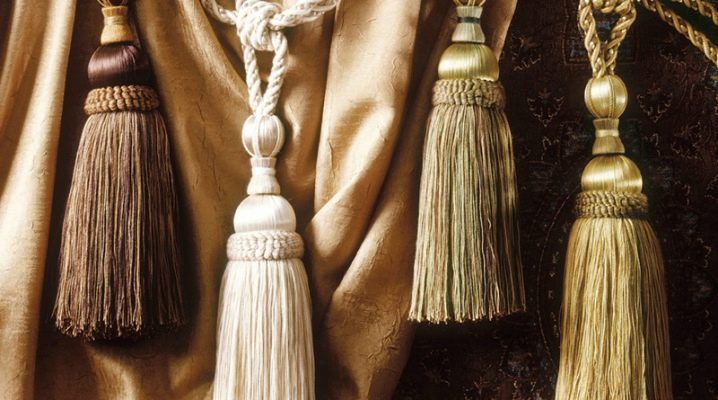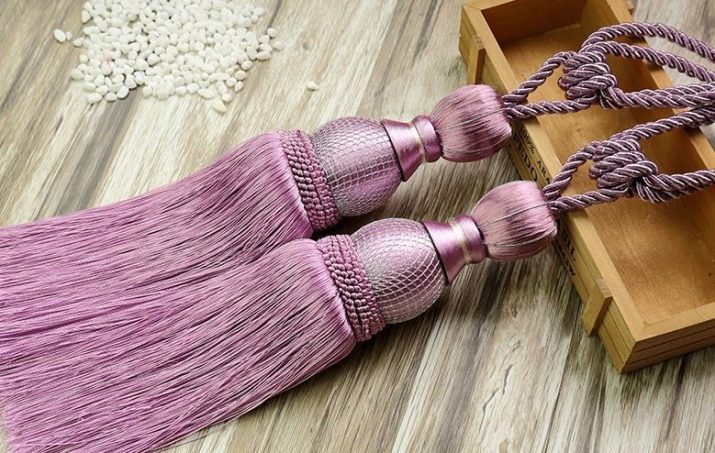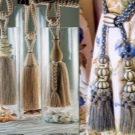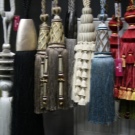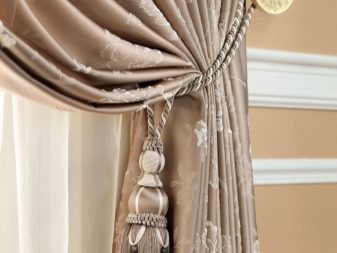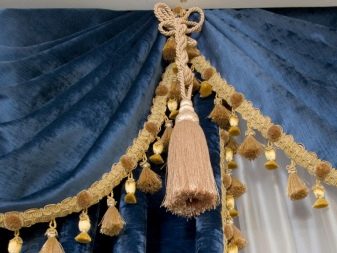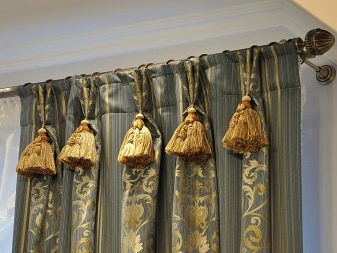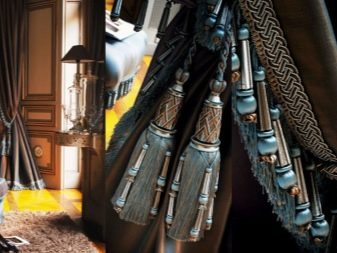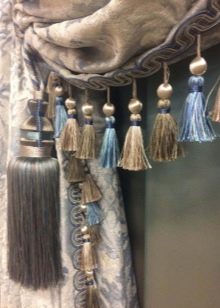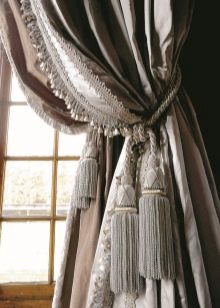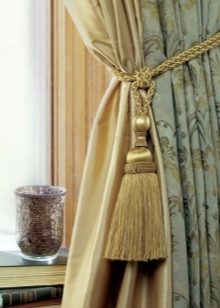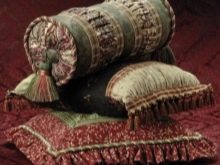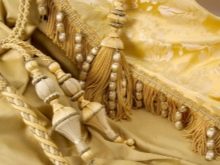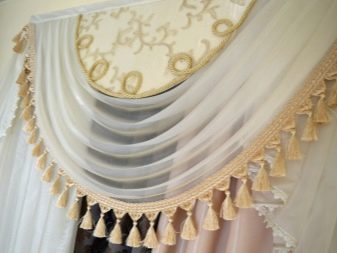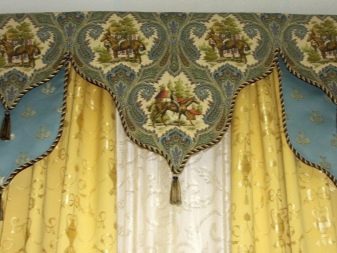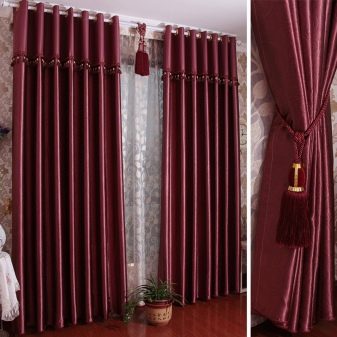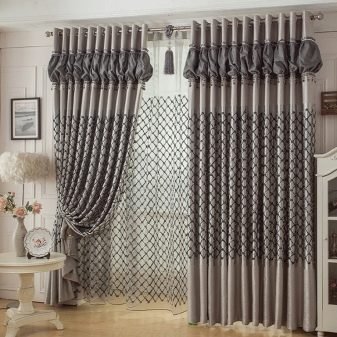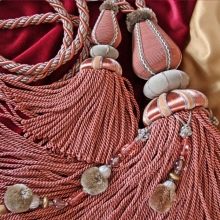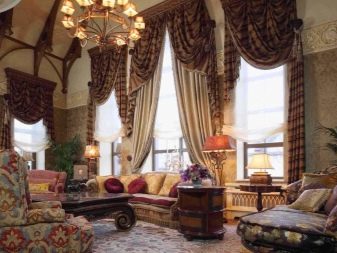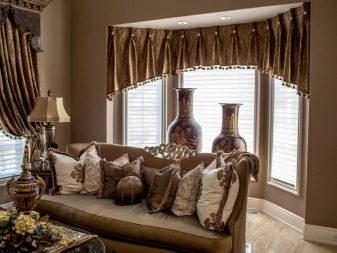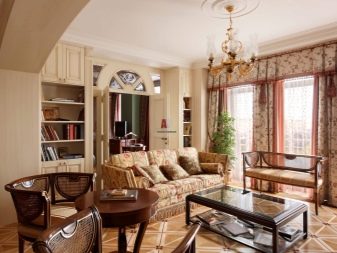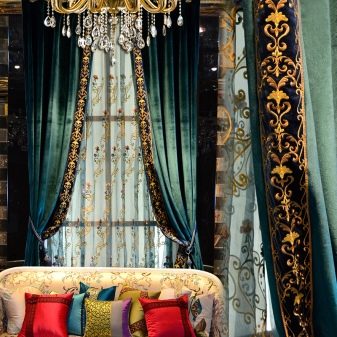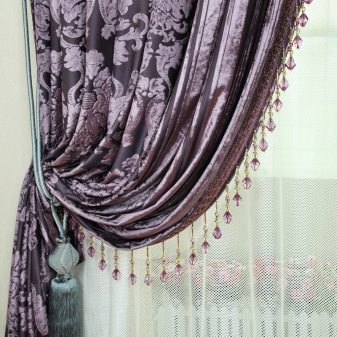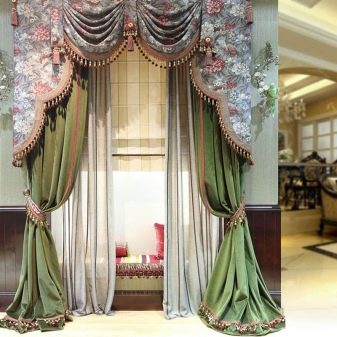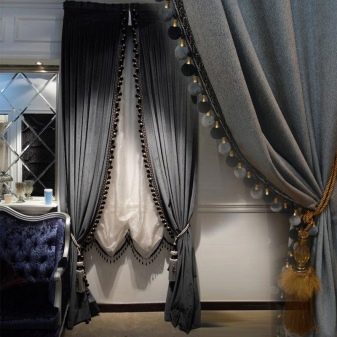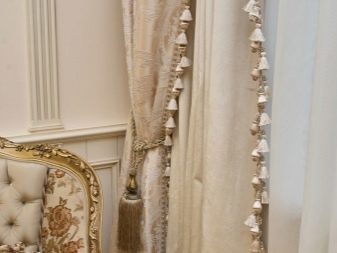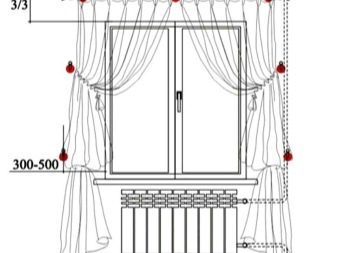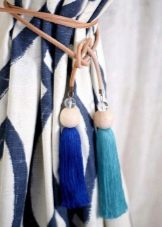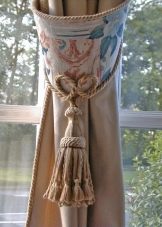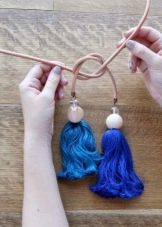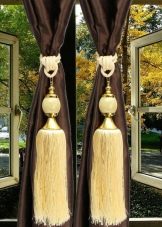Decorative brushes for curtains
Decorative brushes for curtains are decoration elements, giving a special flavor to curtains. Thanks to them, the design of windows looks not only elegant, but also status. About what they are, how to use them beautifully and properly tie, will tell the material of this article.
Features and varieties
Decorative brushes (kutasy) are called because of their ability to transform the appearance of even the most ordinary curtains. Each of them is a bundle of threads, tied with ribbons. The design of brushes can be different, which allows you to perform elements of various shapes and types. Depending on the model, you can use textiles of natural or synthetic origin (for example, organza, wool, cotton) for the manufacture of such jewelry.
In addition to threads, ribbons and textiles, additional decorations are often used for decorative brushes: beads, glass beads and various crystals. In the old days, instead of them, brushes were decorated with precious stones and semiprecious metals. Brushes may vary in size, color and design. They differ in the type of attachment, and the location on the curtains.
Based on this, they can:
- be sewn to the curtain itself;
- be placed with equal pitch along the edges of the canvases;
- to be fixed on pickups, making up a single functional product.
In this case, large brushes, as a rule, are used for pickups, analogs of a small size - for decorating the edging curtains, as well as brushes in the form of balls. The shape of brushes, in addition to spherical, can be multi-tiered.
Often, to decorate the curtains, the elements are combined with each other, giving the curtains a stylish and complete design.
Advantages and disadvantages
Decorative brushes are distinguished by aesthetic appeal. They look beautiful, make the curtains special. luxurious. They are able to bring into the design of window openings shades of palace solemnity, due to which they can be used in classical design directions.However, these same products can be a bright highlight of the laconic curtains, if you decorate with them, say, only holders.
They are variable in size, which allows you to select the desired size of the decor, which will look harmoniously with the curtains. For example, smaller items can be used for decorative tape, attaching them to it with a uniform pitch. Products made from thicker, larger yarns are better decorated with holders. In this case, the brushes themselves are varied in colors.
They can be matched to the curtains that already exist, which will create the illusion of a single set. And if you pick up small tassels for them and decorate them with, say, sofa cushions or a rug, this will create the integrity of the interior design. In addition to the cushions, you can add curtains with tassels with decorative capes on stools or poufs. There may be a lot of options, in this respect everything depends on the creative approach to decorating, the style of the interior and the patterns of the curtains themselves.
However, with all its beauty, decorative brushes are not suitable for decorating special curtains. As a rule, such canvases are self-sufficient, compact and designed in a minimalist design.Their transformation system does not provide for additional elements.
Brushes are good for massive curtains, but for those that barely cover the glass window, they are not intended.
Design options
Decorative brushes can be used for curtains with a variety of folds, scallops and draperies. For example, one of the successful solutions would be decorating their curtains with lambrequin. Despite the fact that today it is carried out in the form of a rigid upper insert without a tail, fixed on both sides, the main panels can be draped in a variety of ways. In the classic version of the brush can be hung on the hooks on both sides.
You can also decorate Austrian curtains with this decor, which before assembly are practically the same as regular rectangular canvases. When assembled, they take the form of festoons, rising up. These curtains can be decorated with small tassels, stitching them to a decorative braid on the bottom edge of the curtains. This type of raised curtain will look beautiful and unusual.
If desired, you can decorate with decorative tassels and curtains with eyelets. In this case, you can use not two, but only one element, placing it, for example, in the center of the eaves.It will look beautiful in the event that its color matches the colors of the finish or pattern of the curtains. You can sew braid with small tassels to the central edges of the curtains, while not complicating the canvas with other decor.
There are cases when decorative brushes help to fix the laid drapery. Twisted cords delicately intertwined with glass beads, help to complete the design. They can highlight the color of curtains curtains at the base, point out the uniqueness of their texture.
Decorative brushes with twisted hooks are sometimes the only possible solution when heavy curtains need to be fixed.
The nuances of choice
If before traditional products were in price, today the priority is avant-garde and extraordinary solutions. These can be podhvaty and original cords with fringe. And you need to select them, according to the status of the interior, because cheap options will not be able to adequately complete the decoration of windows of luxurious classics, the same English or Italian style. In the same way, light curtains will not look beautiful with bulky and massive tassels.
It is necessary to choose such accessories for curtains thoroughly, starting from the first of all, from the existing style of a particular room.For example, they are good for the direction of Provence, the Roman, Greek, ethnic style, can be used in the avant-garde and even high-tech style. However, in most cases, in order for brushes to look more expressive, the color of the curtains should be monotonous.
Choosing such a decor, it is worth paying attention to the material of the curtains themselves. If the textile does not need it, there is no need to additionally hang on it frilly decor. From this curtains instead of luxury can get ridiculous. Everything should be in moderation.
To pick up the brush you need to take into account the texture of textiles, choosing the common one that will help to harmoniously combine the cloth with the finish. For example, it may be a silky or matte texture of materials, silver plating or embossing.
How to tie a knot?
To knots with brushes looked harmoniously in the interior, It is worth considering a few nuances.
- For example, if the tacks themselves are arranged symmetrically, they need to be tied at the same height, starting from the level of the sill. This is how they are tied up with tassels of classic curtain patterns. This contributes to the harmony of space, and also focuses attention on the uniqueness of the interior.
- If the panels are arranged asymmetrically, one pickup with a brush is placed at the sill level, and the other is below or above the conditional center. This technique will visually expand the boundaries of the room.
To brush looked really beautiful, you need to be able to tie them. The knots above the brush are tied regardless of the type of cord, whether it is braided or twisted.
- Cord to the brushes can be attached by rings or balls of wood. Tying a knot is beautiful and correct is easy, it can be done in different ways. For example, you can attach a double cord to Kutas by wrapping a curtain around it and throwing it on a hook that is attached to the wall.
- You can also take 2 brushes that are attached to two different cords. The cords themselves must be draped and fastened on a hook. Decorative brushes covering the curtain, you need to throw in the cords.
- If there is a bead with a wide hole, it can be used to fasten the junction of the cords and wrap it with a decorative braid. In addition, the connection of cords can be decorated with a bright brooch or even a barrette, made in the technique of kanzashi. In addition to these types of tying, macrame is also very popular today.Such knots look beautiful and allow you to give your design a zest.
- It is possible to tie not only two portieres: with an asymmetrical design of window or door openings, only one curtain can be decorated. If the hook for picking up is used simple, it is better to hide it under the cloth. If he is handsome enough, it must be fixed in a prominent place.
Choosing brushes for decorating curtains, it is important to take into account the external coincidence of the structure of materials. If the curtains are made of natural textiles, it will be more harmonious to decorate them with similar brushes. Kutas for fine textiles (such as tulle) should be small, similar to a fringe. The pattern of the accessory should emphasize the design of the curtains themselves. For concise curtains simple cut it is not necessary to knit complex knots in the grasp.
How to decorate curtains with tassels yourself, see the next video.
